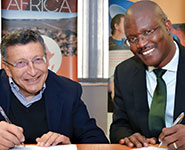Thousand-fold accuracy boost coming to SA time reference
22 July 2015
Editor's Choice
News
The National Metrology Institute of South Africa (NMISA) has committed to upgrading the country’s time and frequency keeping capabilities in order to deliver the accuracy required by the Square Kilometre Array (SKA) and its precursor, MeerKAT.
SKA South Africa, the organisation in charge of this country’s implementation of the futuristic radio telescope, signed a memorandum of understanding with NMISA that will see its time reference accuracy narrowed from 5000 nanoseconds to just 4 nanoseconds.
Dr. Bernie Fanaroff, project director of SKA SA, and Ndwakhulu Mukhuhi, CEO of NMISA, signing the memorandum of understanding between the organisations.
NMISA is mandated to maintain the national measurement standards for South Africa, including those for time and frequency. In this capacity, it keeps the national time (known as South African Standard Time or SAST) and contributes to the calculation of Coordinated Universal Time (UTC).
Precise frequency is necessary to form clear images when using an array of antennas, as is the case with the MeerKAT. Time and frequency constitute the best-known measurement standards as they are based on quantum transitions of atoms. Absolute time is essential in breaking new frontiers. This is required in order to look further into space than ever before at objects where time and space itself is distorted or where the footprints of the universe’s birth can be seen.
The signals from each antenna will reach a data processing centre at different times due to the difference in distance from each antenna. Correlation and beam forming of the signals are necessary in order to make the antenna operate as one big receiver to obtain a high-resolution image of the sky. Correlation relies on precise time tagging of the received signals. The correlating beam former must be very accurately synchronised to the master time reference of the data centre, which itself must be synchronised to UTC.
According to Dr Johan Burger, the man in charge of SKA SA’s time and frequency systems, “time and frequency are critical in the observation of celestial bodies via radio techniques. South Africa will benefit from these technological developments as time and frequency are very important in navigation of aircraft and other vehicles, defence and telecommunications.”
Further reading:
20 years of precision, progress and purpose – the Jemstech journey
Jemstech
Editor's Choice Manufacturing / Production Technology, Hardware & Services
Twenty years ago, Jemstech began as a small, determined venture built on technical excellence and trust. Today, it stands among South Africa’s leading electronic manufacturing service providers.
Read more...
A new era in wire bond inspection
Techmet
Editor's Choice Manufacturing / Production Technology, Hardware & Services
Viscom is developing a 3D wire bond inspection system that incorporates substantially improved sensors, a high image resolution, and fast image data processing.
Read more...
Energy harvesting using a battery-less IoT system
NuVision Electronics
Editor's Choice Power Electronics / Power Management
Energy Harvesting plays an essential role in the foundation of ambient IoT, a new generation of ultra-low power connected devices that operate by drawing energy from their environment instead of relying on traditional batteries.
Read more...
Questing for the quantum AI advantage
Editor's Choice AI & ML
Two quantum experts disclose high hopes and realities for this emerging space.
Read more...
From the editor's desk: Progress meets reality
Technews Publishing
Editor's Choice
In the first half of 2025, renewable energy, incorporating solar, wind, and to a lesser degree hydropower and bioenergy, has generated more electricity globally than coal did.
Read more...
From ER to effortless: The 15-year journey of Seven Labs Technology
Seven Labs Technology
Editor's Choice Manufacturing / Production Technology, Hardware & Services
What started as a business likened to an ‘ER’ for electronic components has today grown into a trusted partner delivering kitting services and full turnkey solutions – taking the effort out of electronics and helping customers truly ‘Move to Effortless.’
Read more...
The trends driving uptake of IoT Platform as a Service
Trinity IoT
Editor's Choice Telecoms, Datacoms, Wireless, IoT
IoT platforms, delivered as a service, are the key that will enable enterprises to leverage a number of growing trends within the IT space, and access a range of benefits that will help them grow their businesses.
Read more...
Interlynx-SA: Engineering SA’s digital backbone
Interlynx-SA
Editor's Choice
At the heart of the industrial shift towards digitalisation lies the growing demand for telemetry, Industrial IoT (IIoT), advanced networking, and robust data solutions, and Interlynx-SA is meeting this demand.
Read more...
Converting high voltages without a transformer
Altron Arrow
Editor's Choice Power Electronics / Power Management
With appropriate power converter ICs, such as the LTC7897 from Analog Devices, many applications can be suitably powered without having to use complex and cost-intensive transformers.
Read more...
Grinn Global: From design house to SoM innovator
Editor's Choice
From its beginnings as a small electronic design house, Grinn Global has moved into the spotlight as a system-on-module innovator working alongside technology giants like MediaTek.
Read more...


